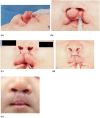Preoperative Correction Using Barbed Sutures as an Alternative to Lip Adhesion for Complete Bilateral Cleft Lip With Prominent Protrusion of the Premaxilla: A Case Report
- PMID: 40741112
- PMCID: PMC12307538
- DOI: 10.1002/ccr3.70694
Preoperative Correction Using Barbed Sutures as an Alternative to Lip Adhesion for Complete Bilateral Cleft Lip With Prominent Protrusion of the Premaxilla: A Case Report
Abstract
Lip adhesion (LA), performed in the treatment of wide cleft lip, is a technique used to relieve tension on the reconstructed lip and improve the outcome of definitive cleft lip repair; however, there are some limitations that need to be addressed, such as the formation of new scarring on the lip and postoperative wound dehiscence, with prominent protrusion of the premaxilla in bilateral cases. A 3-month-old boy underwent preoperative correction for complete bilateral cleft lip with prominent premaxillary protrusion, in which we pulled and attached the lateral lip to the premaxilla and then the contralateral lip to each other with barbed sutures. Definitive cleft repair was performed 1.5 months after the preoperative correction. Adequate preoperative retraction of the protruding premaxilla and reduced suture tension allowed for a definitive cleft lip repair, which resulted in a good lip shape. Preoperative lip and premaxilla correction with barbed sutures is a minimally invasive, simple procedure that can be performed in a short time, and is believed to provide stronger fixation than current methods because of its multi-point fixation with multiple barbs. It also leaves the lip with almost no scarring, which may be advantageous for the definitive repair procedure. Continued follow-up of the patient's lips after development and alveolar cleft surgery is warranted, as is the accumulation of additional cases using the same technique.
Keywords: barbed sutures; complete bilateral cleft lip; lip adhesion; preoperative correction.
© 2025 The Author(s). Clinical Case Reports published by John Wiley & Sons Ltd.
Conflict of interest statement
The authors declare no conflicts of interest.
Figures



Similar articles
-
Infraorbital nerve block for postoperative pain following cleft lip repair in children.Cochrane Database Syst Rev. 2016 Apr 13;4(4):CD011131. doi: 10.1002/14651858.CD011131.pub2. Cochrane Database Syst Rev. 2016. PMID: 27074283 Free PMC article.
-
The Black Book of Psychotropic Dosing and Monitoring.Psychopharmacol Bull. 2024 Jul 8;54(3):8-59. Psychopharmacol Bull. 2024. PMID: 38993656 Free PMC article. Review.
-
Closure methods for laparotomy incisions for preventing incisional hernias and other wound complications.Cochrane Database Syst Rev. 2017 Nov 3;11(11):CD005661. doi: 10.1002/14651858.CD005661.pub2. Cochrane Database Syst Rev. 2017. PMID: 29099149 Free PMC article.
-
The Efficacy of Naso-Alveolar Molding on Premaxilla Pushback and Dentoalveolar Changes in Patients With Bilateral Cleft Lip and Palate.J Craniofac Surg. 2025 May 1;36(3):956-960. doi: 10.1097/SCS.0000000000010762. Epub 2024 Oct 14. J Craniofac Surg. 2025. PMID: 39400181
-
Single-Stage Pedicle Preputial Tube Substitution Urethroplasty with Corpora Cavernosa Augmentation Using Buccal Mucosa Graft for Primary Peno-Scrotal Hypospadias Re-pair in Adults.Int Braz J Urol. 2025 Jul-Aug;51(4):e20240650. doi: 10.1590/S1677-5538.IBJU.2024.0650. Int Braz J Urol. 2025. PMID: 40105707 Free PMC article.
References
-
- Sasaguri M., Hak M. S., Nakamura N., et al., “A Study of Effects of Hotz's Plate and Lip Adhesion in Patients With Complete Unilateral Cleft Lip and Plate: Follow‐Up Observation Until 5 Years of Age,” Journal of Oral and Maxillofacial Surgery, Medicine, and Pathology 26 (2014): 292–300, 10.1016/j.ajoms.2013.03.002. - DOI
-
- Takahashi S., Ujiie H., Shigematsu T., Tachikawa J., Tanabe H., and Fuma Y., “About Lip Adhesion for Complete Cleft Lip,” Journal of the Japan Society of Oral and Maxillofacial Surgeons 16 (1970): 396–400, 10.5794/jjoms.16.396. - DOI
-
- R. Millard, Jr. , Cleft Craft: The Evolution of Its Surgery—Volume II: Bilateral and Rare Deformities (Little Brown and Company, 1977).
LinkOut - more resources
Full Text Sources

